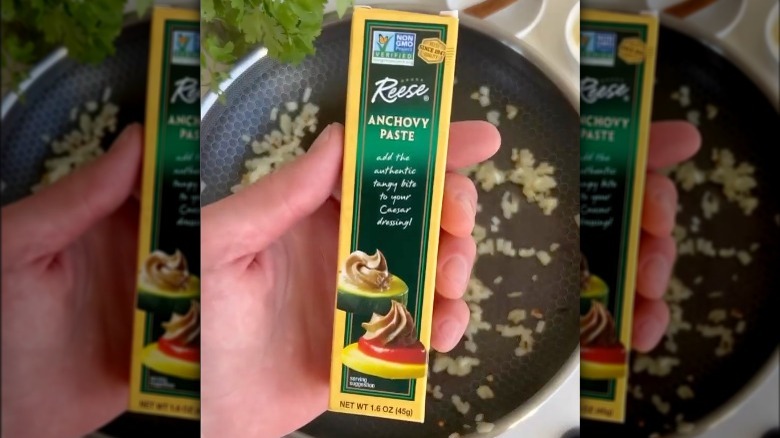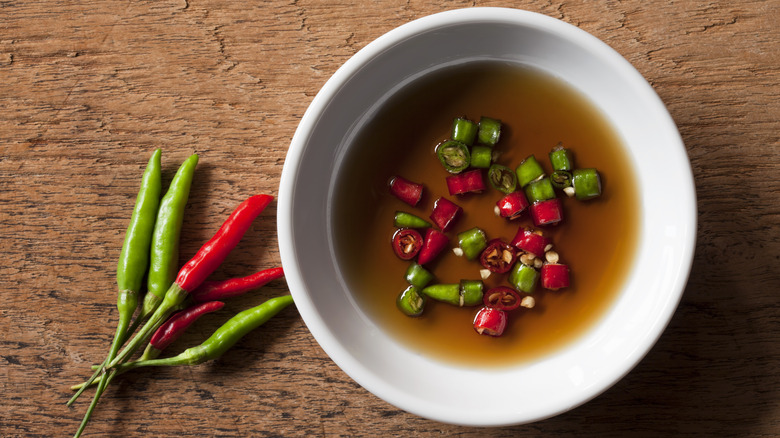The Fishy Alternative That Substitutes As Soy Sauce In A Pinch
Soy sauce is a refrigerator staple, but whether due to allergies, intolerances, or preferences, not everyone enjoys this salty-savory condiment. Substitutions abound, including coconut aminos and tamari, but you can look to other ingredients to provide the same flavor profile, as well. One ingredient that approximates the taste of soy sauce in recipes well is anchovy paste; this fish-packed ingredient is a concentrated concoction of anchovies, salt, and sometimes olive oil, and it contains enormous flavor in a small package.
Just a small squeeze of anchovy paste in a recipe like fried rice or stir-fry adds the same salty, umami flavor to the dish as a drizzle of soy sauce. Though historically this paste has commonly been used in Italian cooking, it can seamlessly be adapted into a variety of different cuisines. When used sparingly and mixed with other strong flavors like meat and spices, it melds in and enhances the taste of the foods around it. Though it's not an exact replica of the taste of soy sauce and lacks the balance of sweetness that the fermented, soy-based condiment provides, its flavor notes are mostly salt and umami; don't worry about your food tasting like the ocean though, as the fishy flavor of the anchovies is muted in this product, especially when used in the context of a multi-component recipe. The ratio to exchange these two ingredients is approximately 1-to-1, though we recommend adding a small amount of anchovy paste first and tasting as you add.
Why anchovy paste works like soy sauce
There's a reason why anchovy paste makes such a great substitute for soy sauce — more so than other salty ingredients like, say, pickles or capers. Both anchovies and soy sauce contain glutamate, the naturally occurring compound that gives foods a deeply savory, umami flavor. Soy sauce contains up to 1,700 milligrams of this compound per 100 grams; anchovies (which make up the bulk of anchovy paste) clock in at about 630 milligrams per 100 grams, which is still nothing to sneeze at.
This umami flavor is what provides that savoriness to foods beyond just the sensation of saltiness; it's an essential flavor profile for many dishes that call for soy sauce. Using anchovy paste can fill both the need for sodium and umami in a dish, making this fishy ingredient a better substitute than other condiments with less glutamate.
Anchovy paste works wonderfully blended into sauces, added to broth and stock, used in meat marinades, and more. Soon you'll be using this secret ingredient so much that it'll have a permanent place in your refrigerator.
Another fishy soy sauce alternative
If anchovy paste isn't available to you, or you'd rather stick with sauces over pastes, there's another fishy, umami-forward soy sauce substitute you can use next time you're in a pinch. Fish sauce, a condiment made from fermenting fish into a funky, salty liquid, can also fill in if necessary. Fish sauce actually comes from fermenting fish like anchovies, so the glutamate in these small creatures gets imparted into the finished product, adding that same characteristic burst of umami you'd find in the paste.
Fish sauce has an extremely strong smell and flavor to it; it's very pungently fishy, so as with anchovy paste, use it sparingly and taste as you go. You can use about a 1-to-1 ratio of fish sauce to anchovy paste. But don't fear ruining your meal with a dash or two — you may be shocked at how well this sauce can meld into the background of dishes it's added to, providing a distinct umami flavor and saltiness without turning the whole thing into a fish overload. So the next time you're out of soy sauce, don't fret; you have other, fishier options to help make your meal a delicious success.


